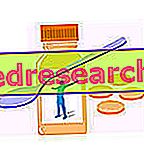What are
What are electrolytes?
Electrolytes - singular: electrolyte - are defined as: substances produced in an electrically conductive solution and dissolved in a polar solvent, for example water.

In the medical field, this chemical definition takes on a more specific role; the electrolytes of the human body, in fact, are: the substances - mainly ionic - dispersed in the physiological liquids, intra- and extracellular, including: cytosol, interstices, cerebrospinal matrix, plasma / blood serum, lymphatic fluid etc; they not only tend to forcefully balance in the same compartments, but also interact between environments biologically separated by tissues, cells and therefore membranes. At the base of homeostasis, therefore of health and life itself, there is the control and exploitation of electrolytes by the body.
The man acquires the electolites with the diet and they correspond, or they belong, of those that generally we define mineral salts .
Did you know that ...
The word "electrolyte" comes from the Greek "lytós", which means "able to be dissolved".
How do electrolytes react?
The dissolved electrolytes separate into cations and anions - which have an electric charge respectively positive in the first case and negative in the second - and disperse, in relation to the chemical-physical mechanisms of the case, uniformly in the solvent. Electrically speaking, a solution so structured, in equilibrium, is called neutral . If an electric potential is applied to this solution, the cations of the solution are attracted by the electron-rich electrode, while the anions are attracted by the electron- poor electrode . The movement of anions and cations in opposite directions within the solution is equivalent to a current . This includes most soluble salts, acids and bases. Even certain gases, such as hydrochloric acid (HCl), under high temperature and / or low pressure conditions can behave exactly like electrolytes. Electrolytic solutions can also be obtained by the dissolution of various biological polymers - for example DNA, polypeptides - and synthetics - for example sulphonated polystyrene - which are therefore called polyelectrolytes - contain charged functional groups. According to these principles, a solution that dissociates into ions acquires the ability to conduct electricity. Sodium, potassium, chloride, calcium, magnesium and phosphate are examples of electrolytes, informally known even as " quarrels ".
History
In 1884 Svante Arrhenius explained that the crystalline, solid salts, when dissolved, dissociate into coupled charged particles; for his dissertation, Arrhenius won the Nobel prize for chemistry in 1903. The explanation clarified that, in forming a solution, salt dissociates into charged particles - to which Michael Faraday had given the name of "ions" many years before. Faraday's belief was that ions could be produced in the electrolysis process; Arrhenius instead proposed that, even in the absence of electric current, the solutions of salts may contain ions, defining that the chemical reactions in solution are reactions between ions.
How are electrolytes formed?
Electrolytic solutions are normally formed when a salt is placed in a solvent - like water - and the individual components dissociate due to the thermodynamic interactions between solvent and solute molecules, in a process called " solvation ". For example, when cooking salt - sodium chloride (NaCl) - is put into water, the salt - which has a solid consistency - dissolves in its component ions, according to the dissociation reaction:
NaCl (s) → Na + (aq) + Cl- (aq)
It is also possible that certain substances, therefore not necessarily salts, react with water producing ions. For example, the carbon dioxide gas or carbon dioxide (CO2), dissolving in water produces a solution containing hydronium ions (H3O +), carbonate and hydrogen carbonate (HCO3-).
Molten salts can give the liquid the ability to conduct electricity . In particular, ionic liquids, which are made up of molten salts having a melting point lower than 100 ° C, are highly conductive non-aqueous electrolytes and have therefore increasingly found application in fuel cells and batteries.
An electrolyte in a solution can be described as concentrated if it has a high concentration of ions, or diluted if it has a low concentration. If a high proportion of the solute dissociates to form free ions, the electrolyte is strong ; if most of the solute does not dissociate, the electrolyte is weak . The properties of electrolytes can be exploited by using electrolysis to extract constituent and / or compound elements contained in the solution.
The alkaline earth metals form hydroxides which are strong electrolytes with limited solubility in water, due to the strong attraction between their constituent ions. This limits their application to situations where high solubility is not required.
Physiology
Importance of electrolytes in physiology
In physiology, the primary ions of electrolytes are:
- Sodium (Na +)
- Potassium (K +)
- Calcium (Ca2 +)
- Magnesium (Mg2 +)
- Chloride (Cl-)
- Hydrogen phosphate (HPO42-)
- Hydrogen carbonate (HCO3-).
The electric charge symbols plus (+) and minus (-) indicate that the substance is ionic in nature and has an unbalanced distribution of electrons caused by chemical dissociation. Sodium is the main electrolyte found in extracellular fluids and potassium is the main intracellular electrolyte; both are involved in fluid balance and blood pressure control .
All known higher life forms require a thin and complex electrolyte balance between intracellular and extracellular environments. In particular, the maintenance of precise osmotic gradients of electrolytes takes on a fundamental role. These gradients influence and regulate the body's hydration and blood pH, and are essential for nerve and muscle function . There are various mechanisms in living species that keep the concentrations of different electrolytes under strict control .
Both muscle tissue and neurons are considered the electrical tissues of the body. Muscles and neurons are activated by the electrolytic activity between the extracellular or interstitial fluid and the intracellular fluid. Electrolytes can enter or exit cells through specialized protein structures incorporated into plasma membranes called ion channels . For example, muscle contraction depends on the presence of calcium (Ca2 +), sodium (Na +) and potassium (K +). Without sufficient levels of these key electrolytes, abnormalities such as muscle weakness or even involuntary contractions may occur.
The electrolyte balance is maintained with the diet and various physiological mechanisms regulated by the hormones, which generally interact with the renal function which tends to eliminate excess electrolytes - with the urine - and to preserve as much as possible those deficient avoiding their expulsion. In humans, the electrolyte homeostasis is regulated by various hormones such as antidiuretics, aldosterone and parathyroid hormones.
Medicine
Medical use of electrolytes
In medicine, electrolytes are used, such as food supplementation or even intravenous injection - although always in solution - when a person shows an imbalance of the same; this, which may be mild or severe, is often caused by: vomiting, diarrhea, excessive sweating, malnutrition, intense athletic activity, etc.
On the market are available supplements to be diluted or electrolyte solutions, in particular for children and elderly patients, and for athletes. Electrolyte monitoring is particularly important in the treatment of anorexia and bulimia nervosa .
Severe electrolyte disorders, such as dehydration and hyperhydration, can lead to cardiac and neurological complications and, unless they are quickly resolved, a potentially lethal medical emergency.
Electrolyte measurement
Electrolyte measurement is a fairly common diagnostic procedure, performed by blood analysis with ion-selective electrodes or urine analysis by laboratory technicians. It is however good to remember that, without an evaluation of the clinical history, the interpretation of the single values is not particularly useful. The most frequently measured electrolytes are sodium and potassium. Chlorine levels are detected almost exclusively for assessments of arterial blood gases, since they are intrinsically linked to sodium levels. A particularly important test conducted on urine is the specific gravity test to determine the onset of electrolyte imbalances.
Rehydration
Electrolytes and rehydration
In oral rehydration therapy - we remind you that dehydration is considered one of the electrolyte imbalances or a condition related to them - electrolytic beverages containing sodium and potassium salts are administered to restore both body water and electrolyte concentrations. This occurs especially in the event of dehydration caused by:
- Malnutrition
- Diaphoresis - too intense sweating - caused by intense and prolonged physical exercise, unfavorable weather conditions or both
- Excessive alcohol consumption
- Diarrhea
- He retched
- Intoxications and any complications.
Athletes who exercise in extreme conditions - for three or more consecutive hours, as happens for example in marathons or triathlons - and who do not consume electrolytes risk dehydration or hyponatremia - lack of sodium in the blood.
An example of an electrolytic beverage, to be produced comfortably at home, can be based on: water, sucrose and table salt, provided that the proportions are adequate . Alternatively, various formulas are available on the market, both dry to dilute and ready to use - also for veterinary use.
Electrolytes are commonly found in foods; for more precision on the nutritional sources of sodium, potassium, magnesium, calcium and chlorine it is advisable to read the dedicated articles. In general, considering that sodium and chlorine are abundant in the western diet - given the abundant use of table salt - and that the average most deficient electrolytes are magnesium and potassium, it may be advisable to increase consumption of vegetables, fruit - also juices - milk, oilseeds and sports drinks.



